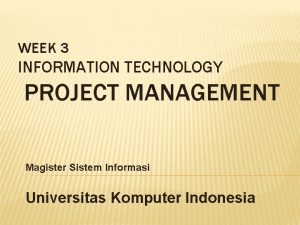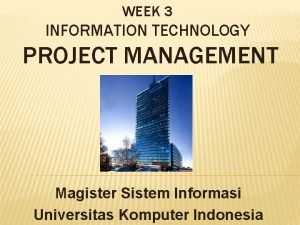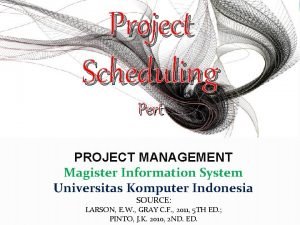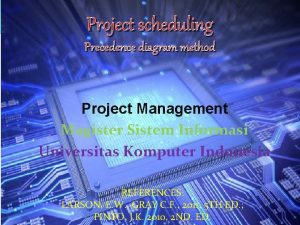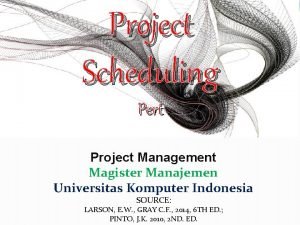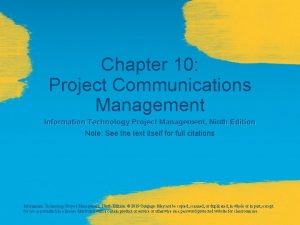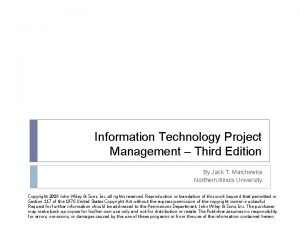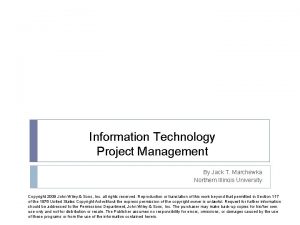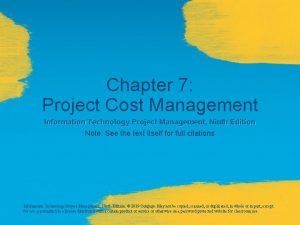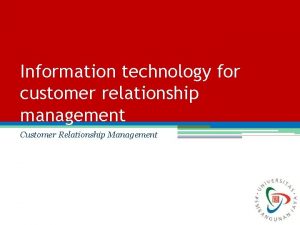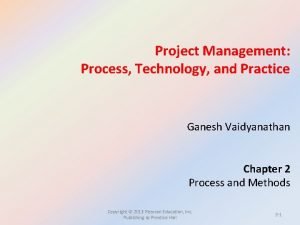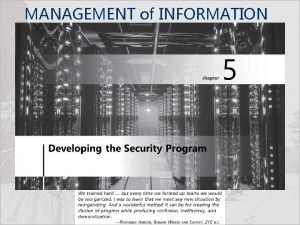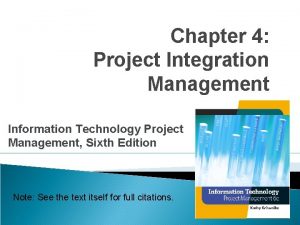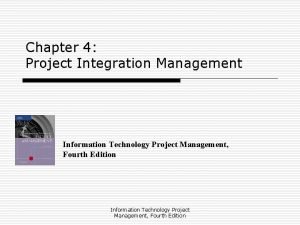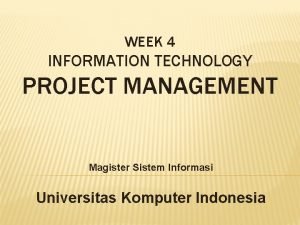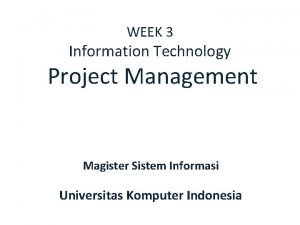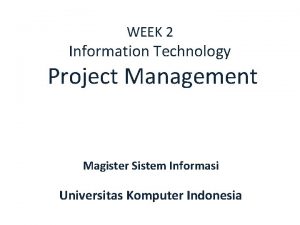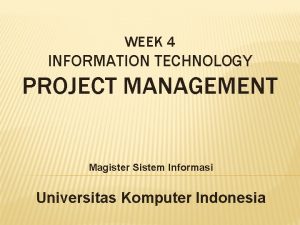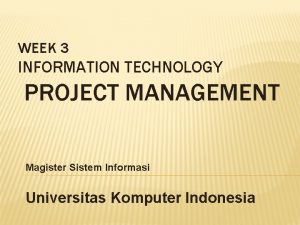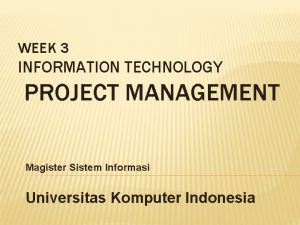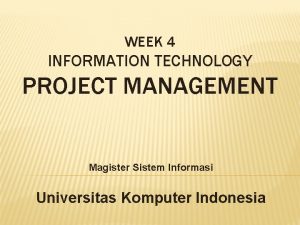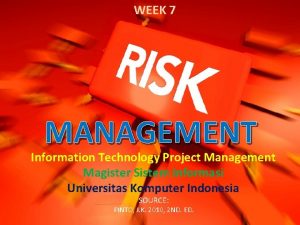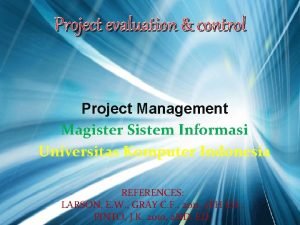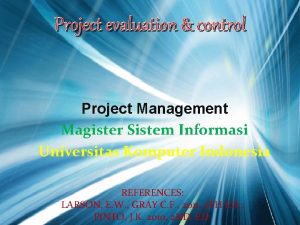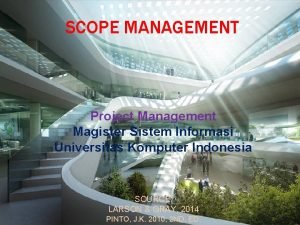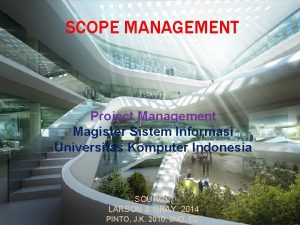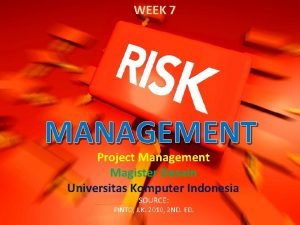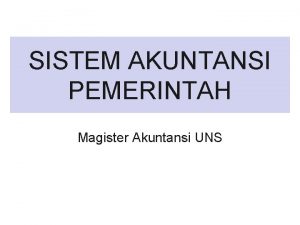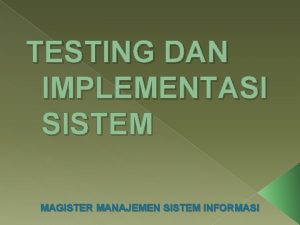WEEK 3 INFORMATION TECHNOLOGY PROJECT MANAGEMENT Magister Sistem
































- Slides: 32

WEEK 3 INFORMATION TECHNOLOGY PROJECT MANAGEMENT Magister Sistem Informasi Universitas Komputer Indonesia

PROJECT SELECTION

WHY PROJECT SELECTION � Survey on companies IT project: over $ 50 billion a year that are created but never used by their intended clients (Pinto, 2010: 92). � Firms are literally bombarded with opportunities, but no organizations enjoys infinite resources to be able to pursue every opportunity. � Selection model permit company to save time and money while maximizing the likelihood of success.

PROJECT SCREENING MODEL Manager should consider five important issues when evaluating screening model: 1. Realism 2. Capability 3. Flexibility 4. Easy to Use 5. Cost 6. Comparability

ISSUES IN PROJECT SCREENING & SELECTION Risk – factors that reflect elements of unpredictability to the firm, including: a. Technical Risk b. Financial Risk c. Safety Risk d. Quality Risk e. Legal Exposure 2. Commercial a. Expected ROI b. Payback Period c. Potential Market Share d. Long-term market dominance, etc. 3. Internal Operating Issues a. Need to develop / train employees b. Change in workforce size or composition c. Change in physical environment, manufacturing or service operations 4. Additional Factors a. Patent protection b. Impact on company’s image c. Strategic Fit 1.

APPROACHES TO PROJECTS SCREENING AND SELECTIONS � Method One: Checklist Model � Method Two: Simplified Scoring Model / Project Screening Matrix � Method Three: AHP � Method Four: Profile Models

CHECK LIST MODEL

CHECKLIST MODEL � Based on a list of criteria that pertain to choice of projects. � Issues in deciding among several new product development opportunities: . Cost of development. Potential Return on Investment. Riskiness of new venture. Stability of the development process. Government or stakeholder interference. Project durability and future market potential

CHECK LIST MODEL - EXAMPLE PROJECT CRITERIA PERFORMANCE ON CRITERIA HIGH MEDIUM LOW Project Alpha Project Beta Project Gamma Project Delta Cost Profit Potential Time To Market Development Risk X X X X

SIMPLIFIED SCORING MODEL

SIMPLIFIED SCORING MODEL � In the simplified scoring model, each criterion is ranked according to its relative importance. � Example: Criterion Importance Weight Time to market 3 Profit Potential Development Risks Cost 2 2 1

EXAMPLE: SIMPLE SCORING MODEL Project Criteria (A) Importance Weight (B) Score (A) X (B) Weighted Score Project Alpha Cost Profit Potential Time To Market Development Risk Total Score 1 2 3 1 2 1 3 2 6 2 13 Project Beta Cost Profit Potential Time To Market Development Risk Total Score 1 2 3 2 2 4 9 4 19 Project Gamma Cost Profit Potential Time To Market Development Risk Total Score 1 2 3 3 1 3 3 6 18 Project Delta Cost Profit Potential Time To Market Development Risk Total Score 1 2 3 2 1 1 3 2 1 2 9 4 16

PROJECT SCREENING MATRIX Criteria Weight Stay Strategi with c fit core compete ncies Urgency 25% of sales from new product s Reduce defects to less than 1% Improve ROI of costume 18% r loyalty plus Weighte d total 2. 0 3. 0 2. 5 1. 0 3. 0 Project 1 1 8 2 6 0 6 5 66 Project 2 3 3 2 0 0 5 1 27 Project 3 9 5 2 0 2 2 5 56 Project 4 3 0 10 0 0 6 0 32 Project 5 1 10 5 10 0 8 9 102 Project 6 6 5 0 2 7 55 Project n 5 5 7 0 10 10 8 83

THE ANALYTICAL HIERARCHY PROCESS � AHP was developed by Dr. Thomas Saaty to adress many of the technical and managerial problems frequently associated with decission making trough scoring models. � AHP step process: 1. Structuring the hierarchy criteria 2. Allocating weight to criteria 3. Assigning numerical values to evaluation dimmensions 4. Evaluating project proposals

STRUCTURING THE HIERARCHY OF CRITERIA � The first step consists of constructing of hierarchy of criteria and sub criteria. � Example: First Level Second Level 1 1 A: Short-term Financial Benefit 1 B: Long-term 2 Contribution to Strategy 2 A: Increasing market share for product x 2 B: Retaining existing customer for product y 2 C: Improving cost management 3 Contribution to IT Infrastructure

ALLOCATING WEIGHT TO CRITERIA � � The second step in applying AHP consists of allocating weight to previously developed criteria and, where necessary, splitting overall criterion weight among subcriteria. Example: Rank Information Systems Project Proposals Goal (1. 000) Finance (0. 520) Strategy (0. 340) Information Technology (0. 140) Short-term Market share Poor Long-term Retention Fair Cost management Good Very Good Excellent

ASSIGNING NUMERICAL VALUES TO EVALUATION DIMMENSION � � For our third step, once the hierarchy is established, we can use the pairwaise comparison process to assign numerical values to the dimensions of our evaluation scale. Example Nominal Priority Poor 0. 00 Fair 0. 1 0. 05 Good 0. 3 0. 15 Very Good 0. 6 0. 30 Excellent 1. 0 0. 50 Total 2. 0 1. 00

EVALUATING PROJECT PROPOSAL � The final step, we multiply the numeric evaluation of the project by the weight assigned to the evaluation criteria and then add up the results for all criteria. Alternative s Total Finance Strategy Short term Long term 0. 1560 Techn ology 0. 3640 Market share 0. 1020 Retenti on 0. 1564 Cost Mgmt 0. 0816 0. 1400 1 Perfect Project 1. 000 Excellen t Excellen t 2 Alligned 0. 762 Good Excellen t 3 Not Alligned 0. 538 Excellen t Good 4 All Very Good 0. 600 Very Good Very Good 5 Mixed Poor Good 3 (0. 300) Fair Good Very Good Excellent Good 4 (0. 600) 5 (1. 000) Excellen t Good Poor 1 (0. 000) 0. 284 Fair 2 (0. 100)

PROFILE MODELS

PROFILE MODELS � Profile Models allow managers to plot risk/return options for various alternatives and then select project that maximizes return while staying within a certain range of minimum acceptable risk.

PROFILE MODEL EXAMPLE Risk Return Potential Project Saturn 10 23% Project Mercury 6 16%

FINANCIAL MODELS

TIME VALUE OF MONEY � Financial models are all predicated on the time value of money. � Money earned today is worth more than money we expect to earn in the future.

PAYBACK PERIOD � Payback Period = investment/annual cash saving

PAYBACK PERIOD EXAMPLE Project A Revenues Outlays Year 0 Project B Revenues Outlays 500, 000 Year 1 50, 000 75, 000 Year 2 150, 000 100, 000 Year 3 350, 000 150, 000 Year 4 600, 000 150, 000 Year 5 500, 000 900, 000

NET PRESENT VALUE � The difference between inflows cash (after tax) and investment outflows. � NPV > 0 accepted NPV < 0 rejected � NPV = PV – I 0, or = CF 1 + CF 2 + …. + CFn – I 0 (1+i)1 (1+i)2 (1+i)n

NET PRESENT VALUE EXAMPLE � Assume you are considering whether or not to invest in a project that will cost $100, 000 in initial investment. Your company requires a rate of return of 10%, and you expect inflation to remain relatively constant at 6%. Future cash flow as follows: Year 1: $ 20, 000 Year 2: $ 50, 000 Year 3: $ 50, 000 Year 4: $ 25, 000

INTERNAL RATE OF RETURN (IRR) � CF 1 + CF 2 + ……. + CFn - Io = 0 (1+IRR)2 (1+IRR)n � If IRR > % required return accepted � If IRR < % required return rejected

IRR EXAMPLE � Suppose that a project required an initial cash investment of $ 5, 000 and was expected to generate inflows of $2, 500, $2, 000, $2, 000 for the next three years. Assume the company rate of return 10%. � Is this project worth funding?

EXAMPLE � Choose which project should be funded based on pay back period, IRR & NPV, at 12% rate. Tahun Proyek A Proyek B 0 (250. 000) 1 100. 000 2 100. 000 200. 000 3 100. 000 0 4 100. 000 0

EXAMPLE Amcott Loses $3. 5 Million; Manager Fired On Tuesday software giant Amcott posted a year-end operating loss of $3. 5 million. Reportedly, $1. 7 million of the loss stemmed from its foreign language division. With short-term interest rates at 7 percent, Amcott decided to use $20 million of its retained earnings to purchase three-year rights to Magicword, a software package that converts generic word processor files saved as French text into English. First year sales revenue from the software was $7 million, but thereafter sales were halted pending a copyright infringement suit filed by Foreign, Inc. Amcot lost the suit and paid damages of $1. 7 million. Industry insiders say that copyright violation pertained to “a very small component of Magicword”. Ralph, the Amcott manager who was fired over the incident, was quoted as saying, “I’m a scapegoat for the attorneys (at Amcott) who didn’t do their homework before buying the rights to Magicword. I projected annual sales of $7 million per year for three years. My sales forecast were right on target. ” Do you know why Ralph was fired? Demonstration Problem 1 – 1 The manager of Automated Product is contemplating the purchase of a new machine that will cost $300, 000 and has a useful life of five years. The machine will yield (year-end) cost reduction to Automated Product of $50, 000 in year 1, $60, 000 in year 2, $75, 000 in year 3, and $90, 000 in year 4 and 5. What is the present value of the cost savings of the machine if the interest rate is 8 percent? Should the manager purchase the machine?

 Magister project management
Magister project management Magister project management
Magister project management Magister project management
Magister project management Magister project management
Magister project management Magister project management
Magister project management Information technology project management 9th edition
Information technology project management 9th edition Information technology project management 9th edition ppt
Information technology project management 9th edition ppt Information technology project management 8th edition
Information technology project management 8th edition Information technology project management 9th edition
Information technology project management 9th edition Information technology project management 9th edition
Information technology project management 9th edition Information technology project management
Information technology project management Information technology project management
Information technology project management Week by week plans for documenting children's development
Week by week plans for documenting children's development Importance of software project management
Importance of software project management Definitive estimate range
Definitive estimate range Global information technology management
Global information technology management Information technology resource
Information technology resource Information technology and customer relationship management
Information technology and customer relationship management Project management process technology and practice
Project management process technology and practice Template
Template Project management for information security
Project management for information security Project management information system example
Project management information system example Project management information system example
Project management information system example The role of project management in achieving project success
The role of project management in achieving project success Walker royce software project management
Walker royce software project management Project cost duration graph
Project cost duration graph Introduction to project management kathy schwalbe
Introduction to project management kathy schwalbe Software project evaluation
Software project evaluation Perpetual project closure
Perpetual project closure Microsoft project agile template
Microsoft project agile template Types of terminations
Types of terminations Magister gymnasium novum
Magister gymnasium novum Magister mediacollege amsterdam
Magister mediacollege amsterdam
